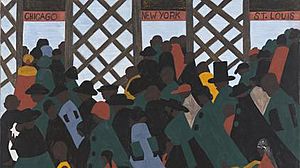Migration Series facts for kids
The Migration Series, first known as The Migration of the Negro, is a collection of paintings. Created by African-American artist Jacob Lawrence, these paintings tell the story of the Great Migration. This was a time when many African Americans moved from the Southern United States to the North. The series was finished in 1941. It received funding from the WPA, a government program.
Jacob Lawrence saw the series as one big artwork, not just separate paintings. He worked on all sixty paintings at the same time. This helped him make sure all the colors matched. It also gave the whole series a united look. Lawrence wrote a short sentence for each painting. These sentences explained what was happening in each picture. Together, the pictures and words tell the full story of the Great Migration.
Contents
About the Artist and His Work
Jacob Lawrence's Early Life
Jacob Lawrence moved to Harlem when he was thirteen years old. Before that, he lived in New Jersey and Pennsylvania. His mother was from Virginia and his father from South Carolina. This meant he knew about the Great Migration from his own family. Lawrence created these sixty paintings when he was only twenty-three years old. This was in 1940 and 1941.
Funding the Art Series
Lawrence received help from the Works Progress Administration. This was a program started by President Franklin D. Roosevelt. The WPA helped many artists during a difficult economic time. It allowed Lawrence to focus on creating his important series.
The Great Migration Story
Why People Moved North
The series shows the Great Migration of African Americans. This movement started in the 1910s. Many people moved from farms in the South to cities in the North. About 1.6 million people moved between 1910 and 1930.
The paintings show the hard life for Black people in the South. They faced low pay and economic problems. For example, a tiny bug called the boll weevil damaged cotton crops. This made it hard for farmers to earn money. The justice system in the South was also unfair to them.
Life in the North
The North offered better wages and more rights. However, it also had its own problems. Cities were very crowded, which led to new health issues. For example, diseases like tuberculosis spread more easily. The last painting in the series shows that the migration continued. People kept moving North even into the 1950s and 1960s.
Changing the Series Name
In 1993, the series was shown in Washington D.C. Its name was changed from "The Migration of the Negro" to "The Migration Series." Also, almost all the captions were rewritten. The word "negro" was common in 1941. But over time, it became less used. The new captions often use "Black" or "African-American" instead.
How the Paintings Were Made
Lawrence's Painting Style
Lawrence used a special type of paint called casein tempera paint. He applied it to hardboard panels. First, he put down a layer of gesso. This was made from rabbit-skin glue and a white powder. Lawrence made his own paint by buying dry colors. He used these colors without mixing them. This helped keep the colors the same across all the paintings.
A Unique Painting Process
He laid out all the panels at once. Then, he would paint one color on every panel. He started with black and then moved to lighter colors. This careful method helped him create a unified look for the entire series.
Art Influences
Lawrence was inspired by Mexican muralism. This was a style of painting popular in Mexico from the 1920s to the 1940s. The Migration Series is like an American version of this powerful art style.
Where to See the Paintings
The sixty paintings are split between two museums. Thirty panels are at the MoMA in New York. The other thirty are at The Phillips Collection in Washington, DC. This split happened in 1942. Sometimes, the entire collection is brought together for special exhibits.


